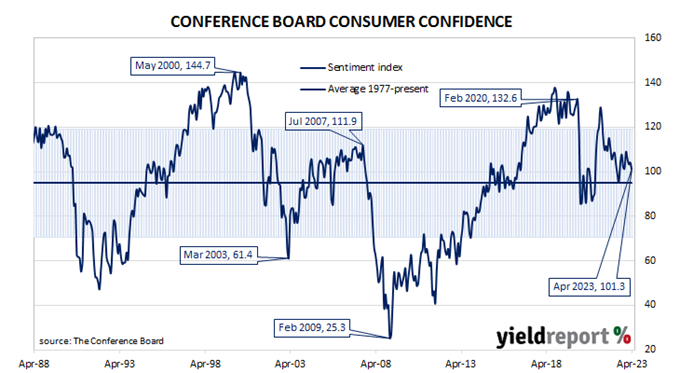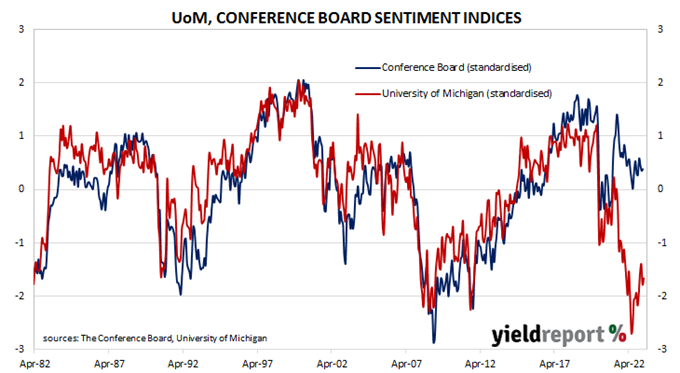Summary: Conference Board Consumer Confidence Index falls in April, less than expected; expectations below level which often signals looming recession; probably picking up full effect of March banking turmoil; views of present conditions improve, short-term outlook deteriorates.
US consumer confidence clawed its way back to neutral over the five years after the GFC in 2008/2009 and then went from strength to strength until late 2018. Measures of consumer confidence then oscillated within a relatively narrow band at historically high levels until they plunged in early 2020. Subsequent readings then fluctuated around the long-term average until March 2021 when they returned to elevated levels. However, a noticeable gap has since emerged between the two most-widely followed surveys.
The latest Conference Board survey held during the first three weeks of April indicated US consumer confidence has deteriorated. April’s Consumer Confidence Index registered 101.3 on a preliminary basis, lower than the expected figure of 104.1 and March’s final figure of 104.2.
“While consumers’ relatively favourable assessment of the current business environment improved somewhat in April, their expectations fell and remain below the level which often signals a recession looming in the short-term,” said Ataman Ozyildirim, a senior director of economics at The Conference Board.
US Treasury yields moved substantially lower on the day on the back of a bank report pointing to continuing stress in the US banking sector. By the close of business, the 2-year Treasury bond yield had dropped by 20bps to 3.93%, the 10-year yield had shed 11bps to 3.39% while the 30-year yield finished 7bps lower at 3.65%.
In terms of US Fed policy, expectations of a higher federal funds rate over the next few months softened while expectations of rate cuts further out hardened considerably. At the close of business, contracts implied the effective federal funds rate would average 5.005% in May, 18bps higher than the current spot rate, and then creep up to an average of 5.035% in June. July futures contracts implied a 5.03% average effective federal funds rate while May 2024 contracts implied 3.62%, 121bps less than the current rate.
NAB Head of FX Strategy (Markets) Ray Attrill said the result was “probably picking up the full effect of the March banking sector turmoil…”
Consumers’ views of present conditions improved while their views of the near-future deteriorated. The Present Situation Index increased from March’s revised figure of 148.9 to 151.1 while the Expectations Index declined from 74.0 to 68.1.
The Consumer Confidence Survey is one of two widely followed monthly US consumer sentiment surveys which produce sentiment indices. The Conference Board’s index is based on perceptions of current business and employment conditions, as well as respondents’ expectations of conditions six months in the future. The other survey, conducted by the University of Michigan, is similar and it is used to produce an Index of Consumer Sentiment. That survey differs in that it does not ask respondents explicitly about their views of the labour market and it also includes some longer-term questions.



